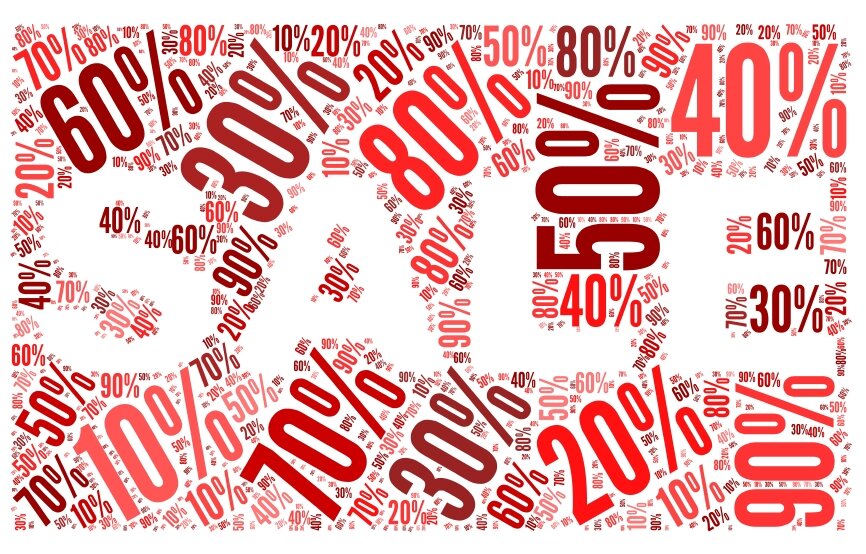Super sale! Tot 80% korting!
Een folder voor de EXTRA MEGA MERKEN MARKT: een grote kledinguitverkoop, waarbij de klant stevige kortingspercentages om zijn oren krijgt. Tot 80% korting! Wat kan de weldenkende consument beter doen dan naar die sale te gaan en zijn slag slaan. Hop, onderweg!
Maar het aanbod valt tegen. Weliswaar allerlei kortingen, maar dat label met 80% korting kom je niet tegen. Ontevreden naar huis, en een klacht indienen bij de Reclame Code Commissie. Want is dit geen misleiding? De Reclame Code Commissie ziet inderdaad bezwaren, maar stelt de adverteerder wel in de gelegenheid om te bewijzen dat er producten met 80% korting worden verkocht. De adverteerder laat een lijst met artikelen zien, waarvan sommigen inderdaad met 80% korting worden aangeboden. Maar dat vindt de Reclame Code Commissie niet voldoende: het is immers niet duidelijk hoeveel stuks per artikel beschikbaar waren. Want: wie met zulke claims adverteert, moet aan kunnen tonen dat een substantieel aantal artikelen beschikbaar is.
Dat doet denken aan een eerdere uitspraak van de Reclame Code Commissie (bevestigd door het College van Beroep) over tijdelijke en beperkt beschikbare aanbiedingen. Kruidvat had in 2008 een actie voor Björn Borg-boxershorts, die met flinke kortingen werden aangeboden. Dankzij de lage prijzen, de hoge populariteit én de beperkte voorraad (gemiddeld 18 Boxershorts per vestiging), waren de boxershorts in no-time uitverkocht. In die zaak benadrukt de Reclame Code Commissie dat het aanbod ‘redelijk’ moet zijn. Daarbij let het op het soort product (bulk/geen bulk, veel/weinig interesse), de aanbieding (hoe lager de prijs, hoe hoger de vraag) en de manier van adverteren (hoe grootschaliger, hoe meer voorraad nodig). Mede gezien de hoge populariteit, hoge kortingen en grootschalige advertentie (in een landelijke folder met een oplage van 6 miljoen exemplaren) vond de Reclame Code Commissie dit aanbod niet redelijk. Misleidend dus.
Dit zijn belangrijke lessen voor de adverteerder. Een scherpe aanbieding is mooi, maar vlieg niet uit de bocht! Anders wordt je aanbieding gezien als een misleidend lokkertje.
Bram Duivenvoorde
Super sale! Discounts up to 80 per cent!
An advertisement for the EXTRA MEGA BRANDS MARKET: a big sales event, offering high discounts to customers. Up to 80 per cent! So what else can a rational customer do than hop on his bike (yes, this is a Dutch customer) and seize the opportunity. Off he goes!
Arriving at the sales event the customer is disappointed. Numerous discounts are available, but that tempting 80 per cent discount label is nowhere to be found. Disappointed, the consumer bikes back home (it has started raining in the meantime), and files a complaint with the Advertising Code Committee. Isn’t the advertisement deceptive?
In order to be able to assess the situation, the Advertising Code Commission requests evidence from the advertiser proving that items with an 80 per cent discount had been sold. The advertiser provides a list of products, some of them being sold with an 80 per cent discount. However, according to the Advertising Code Commission, this is insufficient: it does not prove how many pieces of each product were available. The Commission requires a substantial number of items to be on offer.
This reminds us of an earlier decision of the Advertising Code Committee, which was confirmed by the Commission’s Board of Appeal. The ruling concerned a temporary discount in 2008 of a big Dutch drugstore selling Björn Borg boxer shorts. Attracted by their low prices, high popularity and limited availability (only 18 per store), the boxer shorts were sold out in no-time. In its decision, the Advertising Code Commission emphasizes that the amount of items on offer has to be ‘reasonable’, being determined on the basis of the type of product, the attractiveness of the discount and the scale of the advertising campaign. Taking into consideration the high popularity of the Björn Borg boxer shorts, the high discounts and the large scale of the advertising campaign (advertising leaflets being delivered to homes throughout the country), the Commission concludes that the amount of products on offer was not reasonable.
These are important lessons for any advertiser offering special discounts. It’s great to be able to attract customers, but luring people into your store on false grounds both disappoints customers and puts you at risk of your campaign to be found deceptive.
Bram Duivenvoorde

